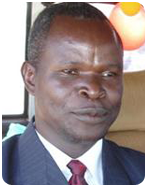John Malala
 He is a graduate of the University of Nairobi (BSc) and the Free University of Brussels/VUB (MSc). He is trained in aquatic ecology, capture and culture fisheries. He is also trained as a Senior Manager (Senior Management Course) at the Kenya School of Government, Mombasa. He is currently a member of the International Lake Environment Committee (ILEC) - Kenya Chapter, ASDSP initiated Lake Turkana Fish Value Chain Platform, Lake Turkana Fisheries Management Plan Committee, Turkana County Natural Resources Management Committee and Western Indian Ocean Marine Scientists Association (WIOMSA). He has over twenty years research experience on Lake Turkana helping to mobilize resources through public private partnership that has enabled KMFRI implement community centered projects on fish post-harvest loss reduction, conservation of fish breeding areas and the Omo River Wetlands. He is a regular participant in collaborative research on Lake Turkana involving both national and international universities and other partners.
He is a graduate of the University of Nairobi (BSc) and the Free University of Brussels/VUB (MSc). He is trained in aquatic ecology, capture and culture fisheries. He is also trained as a Senior Manager (Senior Management Course) at the Kenya School of Government, Mombasa. He is currently a member of the International Lake Environment Committee (ILEC) - Kenya Chapter, ASDSP initiated Lake Turkana Fish Value Chain Platform, Lake Turkana Fisheries Management Plan Committee, Turkana County Natural Resources Management Committee and Western Indian Ocean Marine Scientists Association (WIOMSA). He has over twenty years research experience on Lake Turkana helping to mobilize resources through public private partnership that has enabled KMFRI implement community centered projects on fish post-harvest loss reduction, conservation of fish breeding areas and the Omo River Wetlands. He is a regular participant in collaborative research on Lake Turkana involving both national and international universities and other partners.KMFRI Turkana Research Station
Freshwater Systems Research
FFresh water fisheries and aquatic ecology
Fish ecology and fisheries management • Fish and zooplankton interaction in Lake Turkana • Impact of invasive species Aquatic Ecosystems
jmalala@kmfri.co.ke
malalajohn@gmail.com and jomalala@yahoo,com
University of Nairobi (BSc)
Free University of Brussels/VUB (MSc)
- Aura, C. M, Nyamweya, C. S. Odoli, C. O. Owiti, H., Njiru, J. M., Otuo, P. W. Waithaka, E., Malala, J. (2020). Consequences of calamities and their management: The case of COVID-19 pandemic and flooding on inland capture fisheries in Kenya. Journal of Great Lakes Research 46 (2020) 1767–1775.
- Owino, J., Lomekuya, F., Kemboi, J., Malala, J., Orina, A., Ang’elei, I., Njeru, M., Lukwendah, A., Nyambati. R., Amwatta, J., Cheboiwo, J., Muturi, G. Chikamai, B. (2020). Sustainable management of the natural vegetation cover and fish breeding grounds in the western shores of Lake Turkana. Academia Journal of Environmental Science 8(6): 096-102. DOI: 10.15413/ajes.2020.010.
- Jirsová, D., Štefka, J., Blažek, R., Miloslav, J., Malala, J. O., Lotuliakou, D. E., Mahmoud, Z.N. and Jirk?, M. (2019). From taxonomic deflation to newly detected cryptic species: Hidden diversity in a widespread African squeaker catfish. Scientific Reports | (2019) 9:15748 | https://doi.org/10.1038/s41598-019-52306-2.
- Keyombe, J.L., Malala, J.O., Waithaka, E., Lewo, R.M., Obwanga, B.O. 2017. Seasonal changes in length-weight relationship and condition factor of Nile tilapia, Oreochromis niloticus (Linnaeus, 1758) (Cichlidae) in Lake Naivasha, Kenya. J. Aquat. Biol. 5(1): 7-11.
- Gownaris, N.J., Pikitch, E.K., Aller,J.Y., Kaufman, L.S., Kolding, J., Lwiza, K.M. M. Obiero, K.O., Ojwang, W.O., Malala, J.O. Rountos. K.J. 2016. Fisheries and water level fluctuations in the world's largest desert lake. Ecohydrol. 1– Available online at: http://dx.doi.org/10.1002/eco.1769.
- Long’ora, A.E., Abuom, P.O., Owiti, D.O., Malala, J.O. Influence of Artisanal fishing Gears on Physico-Chemical Parameters of Ferguson’s Gulf in Lake Turkana, Kenya. Sch. Acad. J. Biosci., 3(12):1005-1013.
- Muška, M., Vašek, M., Modrý, D., Jirk?, M., Ojwang, W.O. Malala, J.O., Kube?ka, J. 2012. The last snapshot of natural pelagic fish assemblage in Lake Turkana, Kenya: A hydroacoustic study. Great Lakes Research. 38: 98- 106.
- Ojwang, W.O., Ojuok, J.E., Omondi, R., Malala, J., Abila,R., Ikmat, P. 2010(a). Impacts of river impoundments: the case of hydro power projects on Omo River of Lake Turkana. SAMAKI News, a publication of the department of Fisheries, Kenya VI No. pg. 26-28.
- Werimo, K. and Malala, J. 2009. Improved Live Fish Preservation Using Cages. Report and papers presented at the Second Workshop on Fish Technology, Utilization and Quality Assurance in Africa Agadir, Morocco 24–28 November 2008. FAO Fish. and Aqua. Rep. No. 904. ISBN 978-92-5-006294-5. 23-25p.
- Werimo, K. and Malala, J. 2009. Improved Fish Drying Using a Polythene Solar Dryer. Report and papers presented at the Second Workshop on Fish Technology, Utilization and Quality Assurance in Africa Agadir, Morocco 24–28 November 2008. FAO Fish. and Aqua. Rep. No. 904. ISBN 978-92-5-006294-5. 61-68p.
- Rabuor, C.O., J. Moreau, Malala, J.O., 1998. Growth, mortality and recruitment of Nile Tilapia (Oreochromis niloticus (L.) (Cichlidae) in Lake Turkana (Kenya): Possible variations as assessed by length frequency analysis. J. Trop. Hydrobiol. Fish. 8: 26-34.
Book Chapters
- Malala JO, Keyombe JK, Aura,C, Nyamweya C, Werimo K, Owili M, Olilo C, Ongore C, Yongo E, (2018). The State of Lake Turkana Fisheries (p113-131). In Kimani EN, Aura MC, Okemwa GM (eds.) 2018. The Status of Kenya Fisheries: Towards the sustainable use of renewable aquatic resources for economic development. Kenya Marine and Fisheries Research Institute 1(KMFRI), Kenya. 179 pp.
- Ojwang, W.O., Obiero, K.O., Donde, O.O., Gownaris, N., Pikitch, E.K., Omondi, R. Agembe, S., Malala, J., Avery, S.T. 2016. Lake Turkana: World’s Largest Permanent Desert Lake (Kenya). In C.M. Finlayson et al. (eds.). The Wetland Book. Springer Science+Business Media Dordrecht Available online at: http://DOI 10.1007/978-94-007-6173-5_254-1.
- Johnson, T.C. and Malala, J.O. 2009. Lake Turkana and its Link to the Nile. In H.J. Dumont (ed.), The Nile. Origins, Environments, Limnology and Human Use. Monographiae Biologicae 89:.Springer, Dordrecht Publishers. 207-304.
